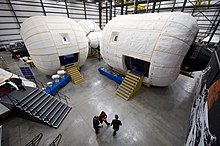Bigelow B330
Bigelow B330 (until 2018 BA 330 , at times also referred to as the Nautilus space complex module ) is a development project by the US company Bigelow Aerospace for an inflatable space station module . It is part of a planned series of modules, the origins of which go back to NASA's Transhab program . With this module, Bigelow Aerospace planned the construction of a private space station for commercial use.
The B330
The B330 uses essentially the same components as the Sundancer module. In contrast to this, it should be about twice as large after unfolding in space and offer a volume of 330 m³. This results in a length of 13.7 m with a diameter of 6.7 m. The volume of the B330 module corresponds to the Transhab concept. Due to the larger volume, it should have a crew capacity of 6 people for a longer period. In a size comparison, the Skylab offered 280 m³ and the MIR space station 350 m³ of habitable space.
The launch of the first B330 module was agreed in April 2016 for 2020 with an Atlas V rocket ; another module should be completed by then. One of the modules was to be coupled to the ISS and would then increase the available interior space by 30%. In 2017 the start was rebooked to the Atlas successor package Vulcan . The planned cooperation with NASA did not materialize, however, and in March 2020 Bigelow Aerospace fired all employees. It was unclear at the time whether the company would restart operations.
Analogous to the Sundancer module, these B330 modules should demonstrate the habitat technology and provide a habitat for a crew so that they can a. could also conduct research under microgravity and pharmaceutical / biotechnology experiments.
In February 2014 the prices for flights and stays in a B330 were published. Staying in a third of a B330 (110 cubic meters) for 60 days should cost $ 25 million. For the flight with a Dragon V2 capsule , which would have been carried out by SpaceX , additional costs of 26.5 million US dollars per person should arise.
Web links
- The B330 on the Bigelow website. Bigelow Aerospace, accessed February 3, 2019 .
Individual evidence
- ↑ BA 330. (No longer available online.) Bigelow Aerospace, archived from the original on October 23, 2012 ; accessed on March 26, 2011 (English).
- ↑ Justin Ray: Atlas 5 to launch commercial space habitat for Bigelow Aerospace. spaceflightnow.com, April 11, 2016, accessed April 12, 2016 .
- ↑ Chris Gebhardt: ULA and Bigelow announce partnership for first commercial space stations. nasaspaceflight.com, April 11, 2016, accessed April 12, 2016 .
- ↑ Bigelow Aerospace and United Launch Alliance Announce Agreement to Place a B330 Habitat in Low Lunar Orbit. United Launch Alliance, October 17, 2017, accessed August 14, 2019 .
- ↑ Bigelow Aerospace lays off entire workforce . Spacenews, March 23, 2020.
- ↑ http://www.gmupolicy.net/aerospace/Contributions-FinalReport.pdf (link not available)
- ^ Yves Grondin: Affordable habitats means more Buck Rogers for less money says Bigelow . In: NASAspaceflight.com , February 7, 2014. Retrieved February 16, 2014.
